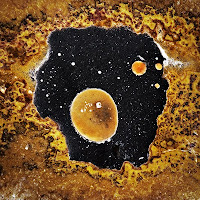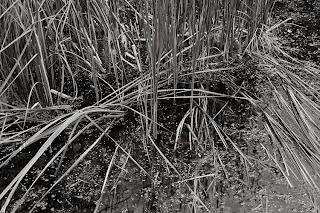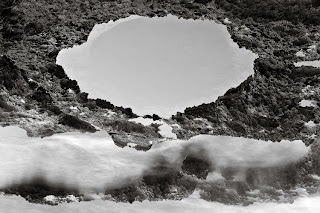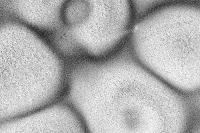
In a recent blog entry (
"Photography as Transcendence"), I presented what I believe is one core component of what distinguishes "fine-art" photography from a "photograph" (even an otherwise technically well executed one). I wrote that the finest photography makes you
forget you are looking at a photograph and makes you experience it as if it were real;
as if you were a part of it. The example I used was (indeed, the whole blog entry was based on) a nude portrait taken by one of the photographers at the photography Co-op I belong to. As such, it was obviously representational; which prompted at least one reader to ask whether I was implicitly arguing that the "finest photography" must depict something real, since how else can the viewer feel she is "one" with the work?
My answer is that photography obviously need not be restricted
in any way in what it represents, or how it represents it. Even the word "photography" is needlessly restrictive. It is useful only insofar as it "points to" something someone has created (which the world calls a "photograph"). But once the physical object is created, the word "photograph" has served its purpose and can be safely discarded. It is the object we care about; or, more precisely, the
affect the object has on us, as viewers. Of course, the degree to which one viewer "feels as one" with a photograph always depends on the viewer's particular predilections and aesthetics. Ardent admirers of
Andy Warhol generally react markedly differently to a given image (whatever the image!) than admirers of the art of
Wassily Kandinsky. But that is the whole point; a point that - upon deeper reflection - may hint at the embryonic stirrings of an
experiential equation of aesthetics:

Before I explain some of the (obvious?) parts of this equation, let me quickly get the "f" (= "function") out of the way. Feel free to disregard it. It is inserted merely as a philosophical placeholder, and for completeness. It reminds us that there is "something" that binds and equates the two sides, but its precise makeup is (for our purposes here) unimportant. It is exceedingly unlikely to have a nice, mathematically well-defined definition. In fact, the best description of what it is a placeholder for is a "human observer" (of "photograph"); and no one, so far as I know (with the possible exception of Stephen Wolfram, developer of
Mathematica and the soon-to-be-released
Wolfram Alpha), has yet been bold enough to posit a "function" for a human being.
"A human being is part of a whole, called by us the 'Universe,' a part limited in time and space. He experiences himself, his thoughts and feelings, as something separated from the rest--a kind of optical delusion of his consciousness." -
Albert Einstein
So what do I mean by this equation? I mean that - ultimately - that the only experience that is of any lasting consequence to an observer viewing a photograph (or any work of art; or anything!) is the
experience itself. That is to say, after all is said and done, after an observer "views" an artwork, the only thing that matters to that observer, the only thing that is of any lasting value, is how - from the observer's own inner point of view - the observer has changed as a consequence of experiencing the artwork. No one can say what that experience will be like, beforehand. The observer is able to reflect back on what the experience was like - on what the artwork means - only after experiencing it (which involves recursive feedback loops on nested experiences, meta-experiences, and the like; none of which we'll get into here). But the observer will be changed in
some way. She may be happy, sad, puzzled, angry, detached, thoughtful, tearful, sardonic, ..., or (though unlikely) she may remain completely unchanged, save for the memory of having physically interacted with the artwork. And it is the way in which our ineffable inner state - our prison-like solitary experience of "I-ness" - changes as a function of our viewing of an artwork that defines
what that artwork means to us, as viewers.
The left-hand-side of the equation thus
represents the inner experience that a viewer has of an observed artwork. The "Photograph" is the physical photograph, and is perhaps the only part of the equation that may be described with something approaching a mathematical rigor. It represents the tangibly objective properties of an image. The paper it appears on, the color dyes and pigments it is imprinted with, its tonal range and contrast levels, and - to some degree - the "things" it depicts (either representationally or non-representationally, as "abstract" shapes and forms; defined mechanically, as by a digital scanner).
The "Context" refers to (1) the context in which the photograph itself appears (perhaps as one of a series of related images, or some other over-arching portfolio of images; is it hanging in a gallery? is it a stray remnant of a discarded box of old polaroids? a web-only image on some unknown photographer's photo-blog?); and (2) the context in which the observer finds herself in while viewing the image, which itself includes both inner and outer dimensions. Is the observer in a gallery setting? is it a private viewing with family and co-workers (the latter set including people to whom she is not as "close")? has she just had lunch with a friend and is in a good mood? has she recently had a spat with her mom and is feeling sad? has she had a long interest in photography, or is perhaps herself a photographer, or is her interest more fleeting?
Finally, "Interpretation" refers to how the viewer interprets the artwork; or the (inner) meaning she ascribes to the work. Interpretation refers to how she really "sees" the work; not necessarily how the work "really" is (objectively speaking, as defined by its physical dimension, the "Photograph"). Note that the viewer does not have to (and, in general, may not even be able to) "see" any of the objectively-hidden "subjective" dimensions of an image, if there are any. Think of the well-known
"Hidden Dalmation" image which consists of black and white patches, and may be "seen" as such by some viewers; or may be "seen" as a dalmation by others. The "Photograph" dimension of this experience is the objective image; the "Interpretation" dimension is either "seeing black and white patches" or "seeing a dalmation" (and its attendant associations: does the viewer like dalmations? is she afraid of them? does it remind her of a childhood incident that, by itself, has nothing to do with dalmations or dogs of any kind?...)
"All our thoughts and concepts are called up by sense-experiences and have a meaning only in reference to these sense-experiences. On the other hand, however, they are products of the spontaneous activity of our minds; they are thus in no wise logical consequences of the contents of these sense-experiences. If, therefore, we wish to grasp the essence of a complex of abstract notions we must for the one part investigate the mutual relationships between the concepts and the assertions made about them; for the other, we must investigate how they are related to the experiences." - Albert Einstein
What the equation E=f(P:C,I) suggests is that whatever an observer experiences by viewing a photograph (or any artwork) is a (likely very complicated) function of (1) the photograph itself, as a physical object; (2) the inner emotional and outer environmental contexts in which the viewer is situated in while viewing the photograph; and (3) the interpretation that the viewer ascribes to the photograph (which, since it is also a function of multiple factors, may be but only one exemplar - true for a given context - of a possibly vast set of alternative interpretations by the same observer).
On a trivial level, we've simply decomposed a single dimension ("Experience") into three. As an academic exercise, it focuses attention on some of the basic factors that influence how we view art in general. Other writers, considerably more esteemed than I (and with deeper results), have gone through this exercise before. For example, the well-known photographer / photography theorist Stephen Shore, in his book
The Nature of Photographs, introduces a similar set of factors (that he calls "levels") for interpretating an image: the
physical level, the
depictive level, the
mental level, and
mental modeling. Each depicts one of the four core elements of an image:
vantage point, frame, focus and
time.
John Szarkowski, the late great photography historian / curator / critic, in his
The Photographers Eye, suggests five dimensions: the
thing itself, the
detail, the
frame,
time, and
vantage point. But however you slice the dimensions - one can always add or subtract to taste - such decompositions, if done thoughtfully, are useful because they partly disentangle the otherwise messy soup of objective and subjective factors that define our overall experience of an artwork.
But what I am after here is subtly different. Assuming that the experience of an artwork is the most meaningful dimension (though, as we've discussed, it too has an ephemeral nature, and may take on added dimensions as the same observer "views" an artwork at different times and in different contexts), what the equation leaves the door open for - at least formally - is the possibility that the same overall experience may result from many different combinations of photograph, context, and interpretation.
Think about that for a moment. Suppose the "Experience" is "feeling joyful, imagining you are in a field of Gold, without a care in the world, and being suddenly transfixed by the notion of Buddhist impermanence" (or anything else, for specificity;-). What gave you this experience? Perhaps it was looking at Ansel Adams'
"Moonrise, Hernandez" at the Smithsonian (where an original print was recently on display, and which induced roughly the same "inner experience" in me as I was viewing it). Although we are conditioned to think of our experience - after the fact - as being synonymous with
what we were viewing (when asked, we reply: "I was looking at the Ansel Adams exhibit"), the more personally meaningful symbolic (and literal) token of our experience is the memory of the
experience itself. It is the memory of what we felt as we were viewing whatever we were viewing; the state of mind we were in, cognitively, intuitively, and emotionally. (For mathematically inclined readers, this is essentially the art-equivalent of taking a Fourier transform between, say, momentum and position space in physics. The respective spaces represent two views of the same system; and do so in a way that
preserves information. In our case, "information" is equivalent to "experience," and the function "f" hints at a Fourier-transform-like "experience preserving" sloshing back-and-forth among three dimensions.)
Now imagine - perhaps in some distant time, when evolution has worked its magic on our cognitive / emotional / aesthetic processing abilities - we are able to recall
experiences as readily as we now recall things and events. Were we such creatures, we would not care whether the "thing" was the "Moonrise, Hernandez" by Ansel Adams (or the "event" a showing at the Smithsonian in Washington, DC in 2008); we would care - and remember - only that there was a moment in our lives when we felt "joyful, imagined we were in a field of Gold, were without a care in the world, and were suddenly transfixed by the notion of Buddhist impermanence." But so many other combinations of
photograph,
context, and
interpretation could have put us into the same state! Depending on the person, perhaps Minor White's
"Capitol Reef, Utah (1962)," viewed on a computer monitor late at night could induce essentially the same experience. Generalizing further, perhaps the same experience may also be had by listening to, say, Beethoven's
Appassionata Sonata with a group of close friends at a local country concert hall.
Getting back to - and expanding upon - the main thesis of the
earlier blog entry, I now state the main conjecture of this blog entry:
the finest photography consists of those images that - for the broadest possible set of contexts and interpretations - yield the most meaningful experiences in the broadest class of observers. Note that the class of "finest photographs" is emphatically not defined solely by the physical dimension of any one photograph; and - critically - includes the observer. "Moonrise, Hernandez" - arguably a fine example of "fine photograph" in the Western world ;-) may rank somewhat lower among the
Aka People of Africa (whose collective "aesthetics" are probably quite different from ours). Photograph and viewer are -
must be - inextricably interwoven and coupled. A "photograph" has no more a single interpretation, and entails no more of a single experience, than a human is defined by a single inner state and experiences life as a single event (though some mystics claim that is precisely what life is). What a photograph "is" (to an observer) depends on - and is, in turn, shaped by - how the observer experiences the photograph; which henceforth becomes part of the observer, and helps shape what other photographs "will be" and the manner in which they, too, will shape the observer.
"I don't believe people are looking for the meaning of life as much as they are looking for the experience of being alive." - Joseph Campbell
Taking a cue from Campbell, we can rephrase the main conjecture of this blog entry as follows:
the finest photography consists of those images that - for the broadest possible set of contexts and interpretations - induce the richest, deepest feelings of being alive in the broadest class of observers.
Thought Experiment #1: What would an artwork that depicts all of the possible artworks, in all of the possible contexts and interpretations that a given observer might ascribe to them, look like, starting with - as an example - Adams'
"Moonrise, Hernandez"? How would an observer of Adams'
"Moonrise, Hernandez" experience this meta artwork? Is there a Borgesian
Aleph of art?
Thought Experiment #2: This blog entry has introduced a formal destinction between a "fine art photograph" and a (run of the mill?) "photograph" as
defined for a group of observers. An obvious question is, what does this distinction entail for the individual observer? Folloing our formulation, we speculate that an observer - say the artist herself? - seeks that combination of artwork, context and interpretation (as any other observer does, of course) that induces the richest, deepest feeling of being alive. Here's a thought experiment: thinking only of yourself as observer (no collective "averaging" is being done here!...this is
you we're talking about!), what would you imagine that artwork to look like that - out of all possible artworks that you can possibly create in this lifetime, and that you can observe in all conceivable contexts so as to form all imaginable interpretations - is the one that makes you feel
most alive? Now go out and create it....
Postscript: the image posted at the top of this blog entry is a triptych of photographs of moonlight, reflected in
Lake Saranac, in the Adirondacks NY. The images were taken from a series captured during a single, exceptionally clear night in August, 2008.




















